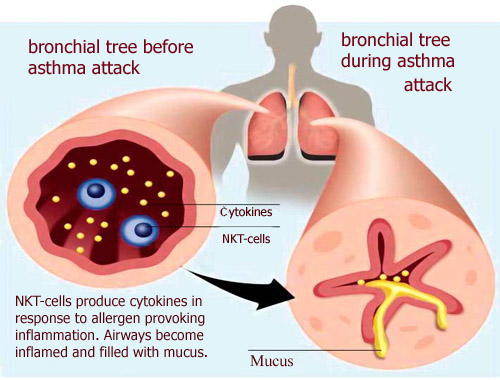Asthma

Published: 18 Jun 2025
ICD9: 493.92 ICD10: J45.901 ICD11: CA23
Asthma is a chronic disease that affects your airways — the tubes that carry air into and out of your lungs.
When you have asthma, your airways can become inflamed and narrow, making it difficult to breathe.
Here's a breakdown of what happens during an asthma attack and some key characteristics of the disease:
What Happens in Asthma:
![]() Inflammation: The airways become swollen and red.
Inflammation: The airways become swollen and red.
![]() Constriction (Bronchospasm): The muscles around the airways tighten, narrowing them.
Constriction (Bronchospasm): The muscles around the airways tighten, narrowing them.
![]() Excess Mucus Production: The airways produce more mucus than usual, further blocking airflow.
Excess Mucus Production: The airways produce more mucus than usual, further blocking airflow.
Key Characteristics of Asthma:
![]() Recurring Symptoms: Asthma symptoms come and go. You might have periods of good breathing interspersed with periods of asthma attacks or flare-ups.
Recurring Symptoms: Asthma symptoms come and go. You might have periods of good breathing interspersed with periods of asthma attacks or flare-ups.
![]() Variability: Symptoms can vary in severity and frequency from person to person and even from day to day in the same person.
Variability: Symptoms can vary in severity and frequency from person to person and even from day to day in the same person.
![]() Triggers: Symptoms are often triggered by specific things, such as allergens, irritants, exercise, or cold air.
Triggers: Symptoms are often triggered by specific things, such as allergens, irritants, exercise, or cold air.
Common Symptoms of Asthma:
![]() Wheezing: A whistling sound when you breathe, especially when exhaling.
Wheezing: A whistling sound when you breathe, especially when exhaling.
![]() Coughing: Can be dry or produce mucus. Often worse at night or early morning.
Coughing: Can be dry or produce mucus. Often worse at night or early morning.
![]() Shortness of Breath: Feeling like you can't get enough air.
Shortness of Breath: Feeling like you can't get enough air.
![]() Chest Tightness: A feeling of pressure or squeezing in your chest.
Chest Tightness: A feeling of pressure or squeezing in your chest.
Causes and Risk Factors:
The exact cause of asthma is not fully understood, but it's likely a combination of genetic and environmental factors. Some risk factors include:
![]() Family History: Having a parent or sibling with asthma.
Family History: Having a parent or sibling with asthma.
![]() Allergies: Especially allergic rhinitis (hay fever) or eczema.
Allergies: Especially allergic rhinitis (hay fever) or eczema.
![]() Early Childhood Respiratory Infections: Certain viral infections in infancy can increase the risk.
Early Childhood Respiratory Infections: Certain viral infections in infancy can increase the risk.
![]() Exposure to Irritants: Such as tobacco smoke, air pollution, and occupational irritants.
Exposure to Irritants: Such as tobacco smoke, air pollution, and occupational irritants.
Diagnosis:
Asthma is typically diagnosed based on:
![]() Medical History: Your doctor will ask about your symptoms, triggers, and family history.
Medical History: Your doctor will ask about your symptoms, triggers, and family history.
![]() Physical Exam: Listening to your lungs with a stethoscope.
Physical Exam: Listening to your lungs with a stethoscope.
![]() Lung Function Tests: Such as spirometry, which measures how much air you can inhale and exhale and how quickly you can exhale.
Lung Function Tests: Such as spirometry, which measures how much air you can inhale and exhale and how quickly you can exhale.
Treatment:
Asthma can't be cured, but it can be effectively managed with medication and lifestyle changes. Treatment goals are to:
![]() Control Symptoms: Reduce the frequency and severity of asthma attacks.
Control Symptoms: Reduce the frequency and severity of asthma attacks.
![]() Prevent Exacerbations: Avoid triggers and take medication as prescribed.
Prevent Exacerbations: Avoid triggers and take medication as prescribed.
![]() Maintain Lung Function: Keep your airways open and clear.
Maintain Lung Function: Keep your airways open and clear.
Common asthma medications include:
![]() Inhaled Corticosteroids: These are long-term control medications that reduce inflammation in the airways.
Inhaled Corticosteroids: These are long-term control medications that reduce inflammation in the airways.
![]() Long-Acting Beta-Agonists (LABAs): These are also long-term control medications that help relax the muscles around the airways. They are typically used in combination with inhaled corticosteroids.
Long-Acting Beta-Agonists (LABAs): These are also long-term control medications that help relax the muscles around the airways. They are typically used in combination with inhaled corticosteroids.
![]() Short-Acting Beta-Agonists (SABAs): These are quick-relief medications (rescue inhalers) that quickly open the airways during an asthma attack.
Short-Acting Beta-Agonists (SABAs): These are quick-relief medications (rescue inhalers) that quickly open the airways during an asthma attack.
![]() Leukotriene Modifiers: These medications block the action of leukotrienes, which are substances that cause inflammation and airway constriction.
Leukotriene Modifiers: These medications block the action of leukotrienes, which are substances that cause inflammation and airway constriction.
Importance of Management:
Proper asthma management is crucial for:
![]() Improved Quality of Life: Allowing you to participate in normal activities without being limited by asthma symptoms.
Improved Quality of Life: Allowing you to participate in normal activities without being limited by asthma symptoms.
![]() Preventing Severe Attacks: Reducing the risk of life-threatening asthma exacerbations.
Preventing Severe Attacks: Reducing the risk of life-threatening asthma exacerbations.
![]() Avoiding Long-Term Lung Damage: Chronic inflammation can lead to irreversible changes in the airways.
Avoiding Long-Term Lung Damage: Chronic inflammation can lead to irreversible changes in the airways.
In short, asthma is a chronic respiratory disease characterized by inflammation and narrowing of the airways, leading to symptoms like wheezing, coughing, shortness of breath, and chest tightness. It is managed with medication and lifestyle changes to control symptoms, prevent exacerbations, and maintain lung function.
If you suspect you have asthma, it's important to see a doctor for diagnosis and treatment. They can help you develop a personalized asthma action plan to manage your condition effectively.